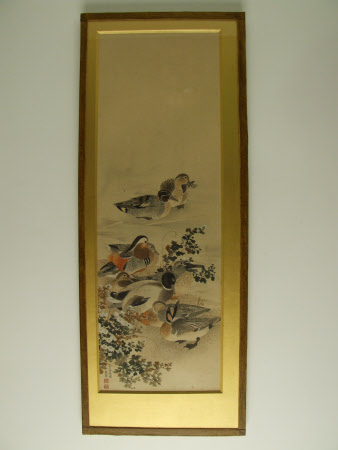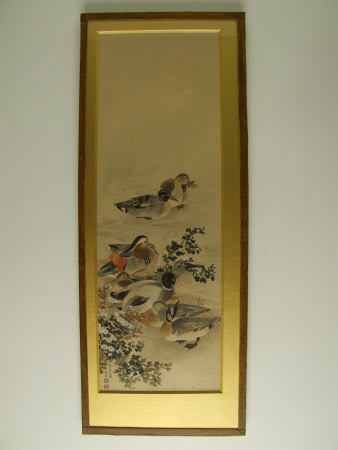Mandarin Ducks
Maruyama Okyo (1733-1795)
Category
Art / Prints
Date
Unknown
Materials
colour woodblock print
Measurements
19 ins (h)7.25 ins (w)
Order this imageCollection
Shaw's Corner, Hertfordshire
NT 1275272
Summary
A Japanese colour woodblock print of nine Mandarin ducks after the original painting by Maruyama Okyo (1733-1795). Marked with the artist’s seals in red, beneath black characters, at lower left. The print is mounted, framed and glazed (gold mount with passe partout frame).
Full description
A Japanese colour woodblock print of nine Mandarin ducks after the original painting by Maruyama Okyo (1733-1795). Marked with the artist’s seals in red, beneath black characters, at lower left. The print is mounted, framed and glazed (gold mount with passe partout frame). Maruyama Okyo was a Japanese painter who founded the Maruyama-Shijo School in Kyoto during the late 18th century. Okyo was influenced by European drawings of nature. His birds are therefore treated with the naturalism typical of Western art, yet retain the Japanese tradition of depicting the subject within a minimal setting and limited use of midtones. Mandarin ducks were a symbol of conjugal fidelity in Japanese culture during the 18th century. The image was possibly created as a hanging scroll, paired with a painting by Okyo of wild geese. The pair were published together in Masterpieces Selected from The Maruyama School (Tajima, 1909, volume I, plates 22-23), and the present woodblock print may have originated from that volume. Shaw’s taste for Japanese prints dates back to his days as an art critic. In a review of an exhibition of Japanese prints held at the gallery of the dealer Thomas Larkin in London in 1888, Shaw reminded his fellow-connoisseurs to make a trip to ‘the collection of Japanese engravings and block prints at the Burlington Fine Arts Club’ before it closed. (Shaw was a member of this private club throughout his life). In the same article he praised the collection of “kakemono” (colour woodblock prints mounted as hanging scrolls) in the British Museum. (Shaw 1989, p. 210). Shaw’s interest in Japanese art and culture continued after his marriage. The influential Japan-British Exhibition was held in London in 1910, and it is no coincidence that in 1912 Shaw has Eliza Doolittle dressing in a kimono after her bath in Pygmalion. (Shaw 1970-74, vol.4, p. 713). The Shaws probably visited the vast Japan-British Exhibition with their friend Charles Ricketts (1866-1931), who wrote a review of the show, and was the designer for the scenery and costumes of several Shaw plays. (Ricketts 1939, p. 151). Ricketts, together his partner Charles Shannon (1863-1937), greatly admired Japanese prints, and their collection, including works by Hokusai, was donated to the British Museum. The Shaws’ collection of Japanese prints was also likely to have been formed with the guidance of their friend Laurence Binyon, who had been appointed Assistant Keeper of the Department of Oriental Prints and Drawings at the British Museum in 1913. Shaw’s collection of Japanese prints reflects his love of nature, particularly birds, and these should be viewed alongside other objects and prints that feature bird imagery in the house. Alice McEwan 2018
Provenance
The Shaw Collection. The house and contents were bequeathed to the National Trust by George Bernard Shaw in 1950, together with Shaw's photographic archive.
Marks and inscriptions
"HARRY C. MURCOTT, /Picture Frame Manufacturer,/ 6, Endell Street, Long Acre,/LONDON W.C." (Paper label on back) Lower left of image: Marked with the artist’s seals in red, beneath black characters, at lower left.
Makers and roles
Maruyama Okyo (1733-1795), artist
References
Shaw, 1989: Bernard Shaw on the London Art Scene 1885-1950. (Ed.) Stanley Weintraub. University Park: Pennsylvania State University Press, 1989 Shaw, 1970-74: The Bodley Head Bernard Shaw: Collected Plays with Their Prefaces, 7 vols. (Ed.) Dan H. Laurence. London: Max Reinhardt, the Bodley Head, 1970-74 Ricketts, 1939: Charles Ricketts, Self-Portrait. (Ed.) Cecil Lewis. London: Peter Davies, 1939 Tajima, 1909: Shiichi Tajima (ed), Masterpieces Selected from The Maruyama School, with biographical sketches of the artists, 2 vols. Tokyo: Shimbi Shoin, 1909

